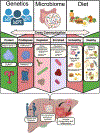Gut microbes, diet, and genetics as drivers of metabolic liver disease: a narrative review outlining implications for precision medicine
- PMID: 39029595
- PMCID: PMC11480923
- DOI: 10.1016/j.jnutbio.2024.109704
Gut microbes, diet, and genetics as drivers of metabolic liver disease: a narrative review outlining implications for precision medicine
Abstract
Metabolic dysfunction-associated steatotic liver disease (MASLD) is rapidly increasing in prevalence, impacting over a third of the global population. The advanced form of MASLD, Metabolic dysfunction-associated steatohepatitis (MASH), is on track to become the number one indication for liver transplant. FDA-approved pharmacological agents are limited for MASH, despite over 400 ongoing clinical trials, with only a single drug (resmetirom) currently on the market. This is likely due to the heterogeneous nature of disease pathophysiology, which involves interactions between highly individualized genetic and environmental factors. To apply precision medicine approaches that overcome interpersonal variability, in-depth insights into interactions between genetics, nutrition, and the gut microbiome are needed, given that each have emerged as dynamic contributors to MASLD and MASH pathogenesis. Here, we discuss the associations and molecular underpinnings of several of these factors individually and outline their interactions in the context of both patient-based studies and preclinical animal model systems. Finally, we highlight gaps in knowledge that will require further investigation to aid in successfully implementing precision medicine to prevent and alleviate MASLD and MASH.
Keywords: Genetics; Gut microbiome; MASH; MASLD; Nutrition; Precision medicine.
Copyright © 2024 Elsevier Inc. All rights reserved.
Conflict of interest statement
Declaration of competing interest The authors declare that there are no conflicts of interest.
Figures


References
-
- Singh S, Allen AM, Wang Z, Prokop LJ, Murad MH, Loomba R. Fibrosis progression in nonalcoholic fatty liver vs nonalcoholic steatohepatitis: a systematic review and meta-analysis of paired-biopsy studies. Clin Gastroenterol Hepatol 2015;13:643–654.e1–9; quiz e39–40. 10.1016/j.cgh.2014.04.014. - DOI - PMC - PubMed
Publication types
MeSH terms
Grants and funding
LinkOut - more resources
Full Text Sources

